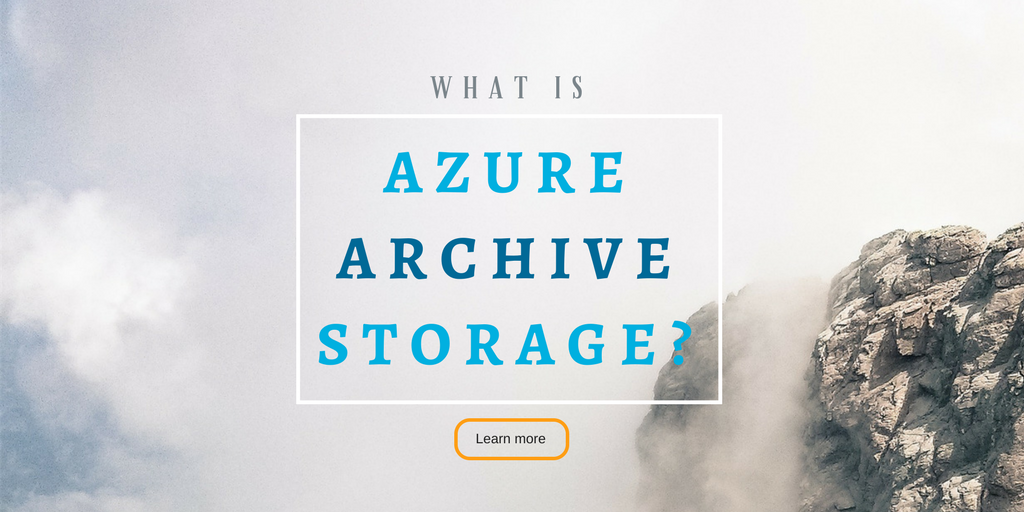Microsoft Azure Archive Blob Storage (AABS) and Blob-level Tiering are now in public preview!
Archive Blob Storage is a new tier in Azure storage that helps make the Azure cloud platform an ideal place to archive data. If you need to keep data for long periods of time but will rarely (or never) access it, then you need to know about the Archive tier.
As the name implies, Blob-level Tiering enables us to define the storage tier at the individual object level.
When Microsoft announced these new features into public preview, we had a celebration at HubStor.
GET A LIVE DEMO OF AZURE ARCHIVE STORAGE AND BLOB-LEVEL TIERING IN ACTION.
What this Means for Blob Storage Accounts
When Microsoft introduced Azure Cool Storage in 2016 to block blob storage in Azure, there became two storage tiers: Hot and Cool.
The Hot and Cool tiers were initially a setting at the storage account level in Azure which meant that all blobs inside an account would have the same tier. Indeed, you could change an account from Hot to Cool, or vice versa, but the tier applied to all blobs in the account.
As an example, if you had 100 terabytes with 80% low-touch data, then you would likely have two blob storage accounts, as follows:

With the introduction of blob-level tiering control, your Azure Blob storage accounts will support a mix of tiers wherein individual items will be either Hot, Cool, or Archive. Furthermore, you can change the tier on one or multiple objects at any time.
Let’s apply our 100 terabyte storage example to this new concept. Instead of multiple storage accounts for the different levels, we simply have one storage account which may have content distributed across the storage tiers, as follows:

How Azure Archive Storage Pricing Works
Data that has not been accessed in over a year is implausible to be retrieved anytime soon.
In the archiving business, we see that it is common for 70% of an organization’s unstructured data to be suitable for deep archive cold storage.
The Archive tier pricing is ideal when you know the following to be true:
- The content has a long or indefinite retention period, and
- Access activity is rare.
You want to be sure about these things before using Archive storage in Azure. That is because of how the pricing is structured. Indeed, storage cost per month on the Archive tier is incredibly small. However, the activity costs are significantly higher than what you will find with the Hot or Cool tiers. The key to containing cloud storage costs is to place the appropriate workload on the optimal tier at the right time.
The following examples use the East US 2 Azure region’s prices for LRS blob storage in USD (with the public preview prices for AABS). In them, we can see significant storage cost savings with Archive versus Cool and Hot, as follows:

What is easy to overlook initially is that there are storage activity costs associated with writing and reading objects into public cloud storage. Keep in mind that the pricing available for AABS today is subject to change in GA. At this time, AABS pricing does not factor early deletion prices, which is a topic for a later post. For now, here is what we have for storage activity prices across the three tiers:

At first glance, these are all small numbers, but at large-scale scenarios they add up. Storage activity costs become more noticeable when you are talking about any workloads that involve large numbers of small files. Email and event logs are good examples. Machine-generated data is another.
There are ways of being creative to mitigate activity costs which we will explore in a future post.
Comparison to Amazon Glacier
Up until now, Amazon Glacier has been the cold storage cloud destination.
We believe Azure Archive Blob Storage is the better enterprise solution for archiving because of its flexibility and convenience. Granular object-level controlling of tiers enables applications to provide a better user experience with more sophisticated data management controls. Unlike Glacier, AABS does not force you to manage your data in sets, and the retrieval experience is cleaner as a result.
Stay tuned as we dig deeper into AABS with future posts because comparing it to Glacier is sure to be a hot topic.
READ: 7 WAYS AMAZON GLACIER FAILS AT CLOUD ARCHIVING COMPARED TO HUBSTOR ON MICROSOFT AZURE.
Availability
During public preview, the new Archive tier is available in the East US 2 region only. Before general availability release, it works with Locally-Redundant Storage (LRS) only.
When Microsoft takes the new feature into general availability, we expect it will support GRS and be more widely available across the Azure regions.
Next Steps for Azure Cloud Archiving
Public preview means that you can access the new Azure features today. HubStor has a tight integration that is tested and ready for use. Obviously, with Archive being in preview, we recommend using HubStor with it in a pilot scenario.
If you are an existing HubStor customer and wish to evaluate AABS, let us know. All we need to do is add a new Stor to your tenant configuration with the AABS features enabled. For that Stor, your HubStor tenant will then display our new features that work with AABS and blob-level tiering controls.
In our next post on this topic, we will explore how you can leverage the new Azure features for archiving with HubStor.


